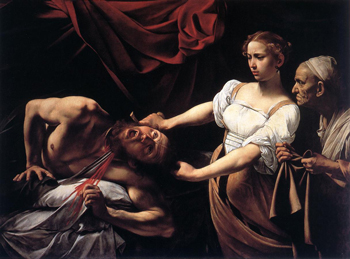| Search Art Prints | ||||||||||||||||||||
| Search Artists | ||||||||||||||||||||

|
||||||||||||||||||||
|
|
|||||||||||||||||||

Judith Beheading Holofernes

|
Judith Beheading Holofernes
‘Judith Beheading Holofernes’ is Michelangelo Caravaggio’s compelling depiction of a story taken from the deuterocanonical Book of Judith, which describes the events that led a young woman to murder the mighty General Holofernes.
From the right of the canvas, Judith appears to have entered the bedroom of her victim Holofernes, accompanied by her hand-maiden; however, an advanced study of the painting indicated that, originally, Judith’s breasts were fully exposed, thereby implying that she had just left the general’s bed. The white chemise that she wears was presumably added later on to cover her upper body.
With Judith tugging at his hair and exposing his neck, Holofernes is yanked awake, bearing a look of shock as the blade cuts his throat. His open-mouth and lifeless eyes stare towards the heavens. Although his hand still clutches onto the bed sheet in an attempt to cling to life, his death is imminent. The painting’s background is extremely dark except for the red bed curtain, which creates a powerful contrast and amplifies the scene’s murderous atmosphere.
‘Judith Beheading Holofernes’ was Michelangelo Caravaggio’s first intensely dramatic tableau, which accurately details the physiology of the figures and magnificently captures this violent passage from life to death. Fillide Melandroni was most likely the model used to portray Judith, as she posed for Caravaggio in many other works created between 1598 and 1599.
Real Life Inspiration
Whilst Caravaggio represented the scene from the Book of Judith, many aspects of the painting have led critics and historians to believe that ‘Judith Beheading Holofernes’ was actually inspired by two very highly publicized executions: the Italian philosopher Giordano Bruno who was burned at the stake for heresy, and more importantly, noble-woman Beatrice Cenci who was molested by her father and conspired with her family to kill him. Caravaggio observed the execution.
About the Artist
Michelangelo Merisi (or Amerighi) Caravaggio studied in Milan under Titian trained Simone Peterzano. He moved to Rome and quickly reached successful artistic merit due to his naturalistic approach and innovative stylistic tenebrism. He soon became popular and in demand. However, finding it difficult to adjust to success, the artist would get involved in countless arguments and physical altercations causing him to spend time in jail. In 1606, after killing a young man during one of his notorious fights, the Pope issued a death warrant against him and Caravaggio fled from Rome. He reportedly died from a fever during his journey back to Rome to receive a pardon.
‘Judith Beheading Holofernes’ is located at the Galleria Nazionale d'Arte Antica, in Rome, Italy.











